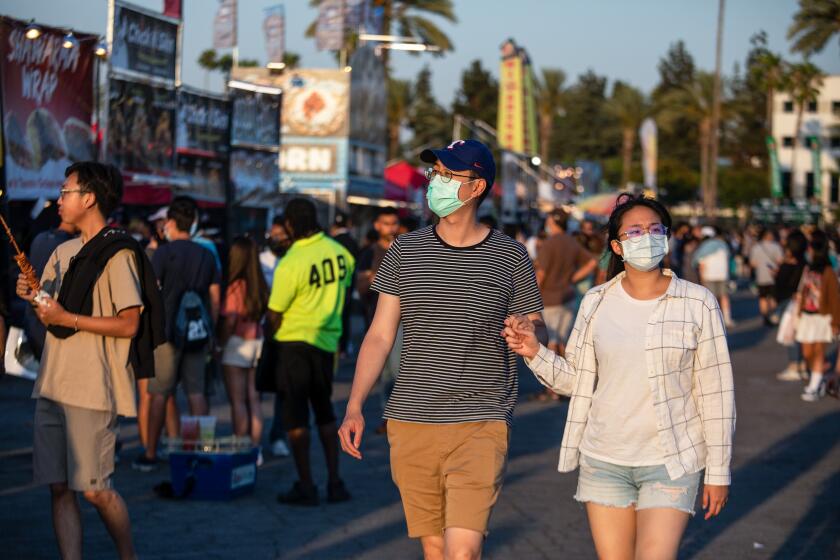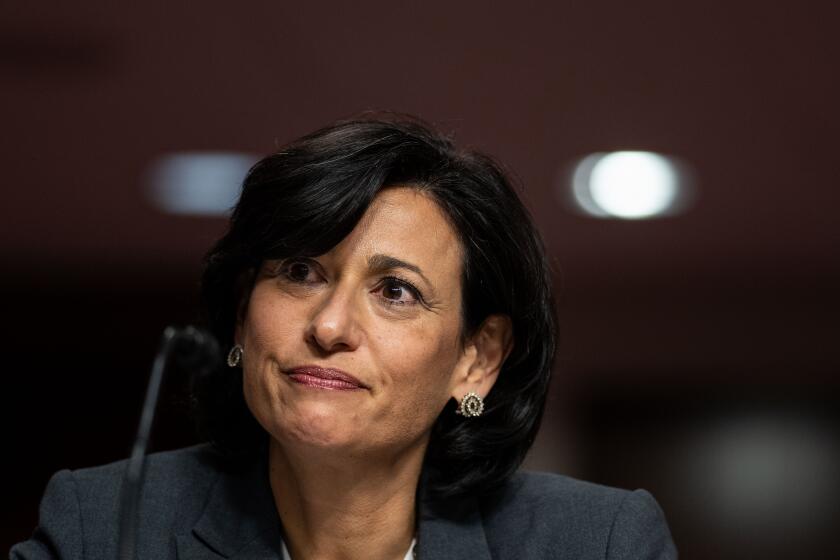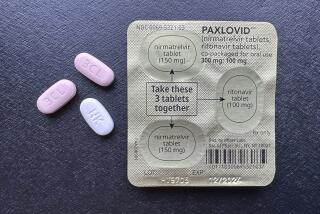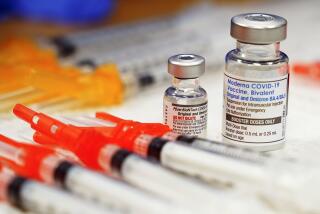More COVID-19 rules fall as CDC hints at better times ahead
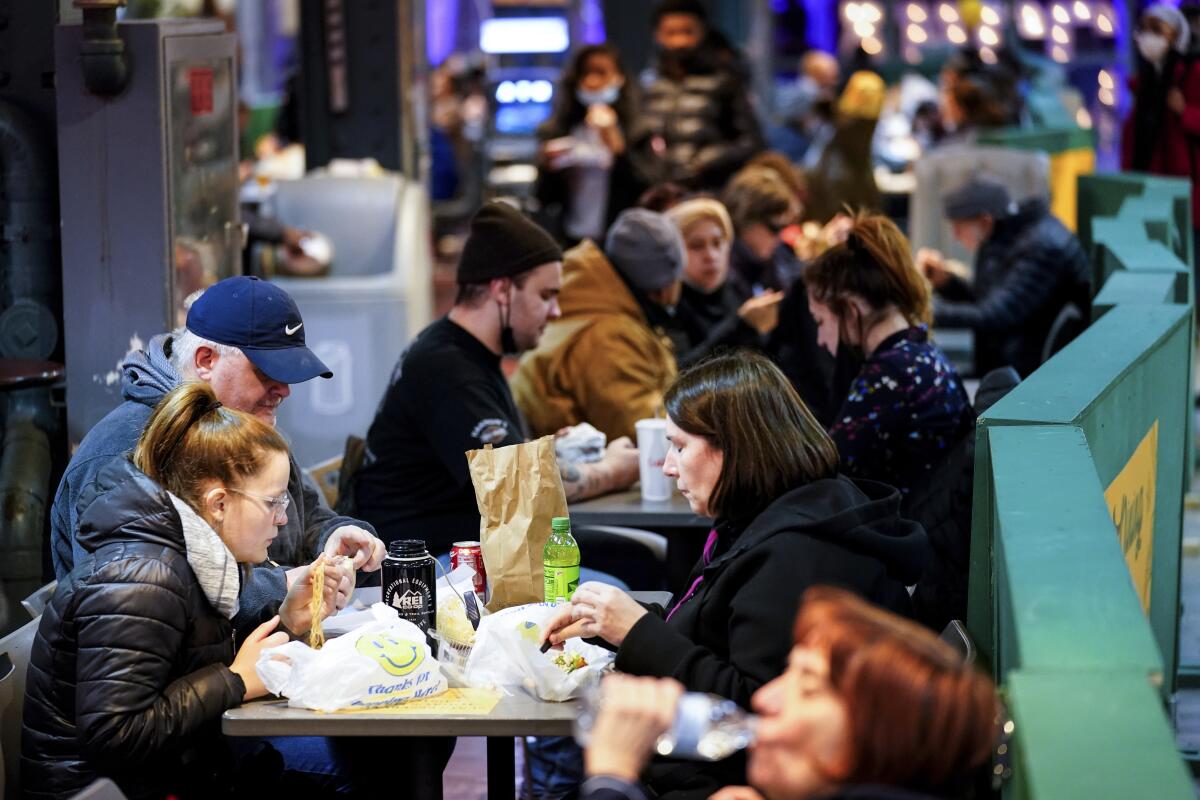
- Share via
The nation’s leading health officials said Wednesday that the U.S. is moving closer to the point that COVID-19 is no longer a “constant crisis” as more cities, businesses and sports venues began lifting pandemic restrictions around the country.
Dr. Rochelle Walensky, director of the Centers for Disease Control and Prevention, said during a White House briefing that the government is contemplating a change to its mask guidance in the coming weeks.
Noting recent declines in COVID-19 cases, hospital admissions and deaths, she acknowledged “people are so eager” for health officials to ease masking rules and other measures designed to stop the spread of the coronavirus.
“We all share the same goal: to get to a point where COVID-19 is no longer disrupting our daily lives, a time when it won’t be a constant crisis — rather something we can prevent, protect against and treat,” Walensky said.
With the Omicron variant of the coronavirus waning and Americans eager to move beyond the virus, government and business leaders have been out ahead of the CDC in ending virus measures in the last week, including ordering workers back to offices, eliminating mask mandates and no longer requiring proof of vaccine to get into restaurants, bars, and sports and entertainment arenas.
The efforts have been gaining more steam each day.
At Disneyland and California Adventure, vaccinated guests will no longer have to wear masks indoors starting Thursday. Professional sports teams including the Utah Jazz and Washington Wizards and Capitals have stopped requiring proof of vaccine for fans.
On Wednesday, state health officials lifted a requirement that all residents age 2 and older wear masks in most indoor public spaces.
Philadelphia officials said Wednesday the city’s vaccine mandate for restaurants was immediately lifted, though indoor mask mandates remain in place for now. Health Commissioner Cheryl Bettigole said the average daily case count had dropped to 189 per day in the city of more than 1.5 million people. The plunge in infections has been steeper in Philadelphia than elsewhere in the state or the country, she said, making it easier to lift the vaccine mandate for restaurants and other businesses that was announced in mid-December and just fully went into effect this month.
“Our goal has always been to the least restrictive as possible while ensuring safety,” Bettigole said.
In Provincetown, Mass., a seaside town that became a COVID-19 hot spot with an early outbreak of the Delta variant last summer, officials on Tuesday lifted a mask mandate and vaccine requirement for indoor spaces such as restaurants and bars. Town Manager Alex Morse said the community of about 3,000 recorded zero active cases last week among residents — something that hasn’t happened since the surge following last year’s Fourth of July celebrations.
“We are learning to live with, and mitigate, the impact of the virus on our community,” Morse said.
As the Omicron variant infects record numbers of people, many in Southern California say they are no longer willing to hide from a virus that has already killed 800,000 Americans.
Coronavirus infections and hospitalizations have fallen sharply in the U.S., with the seven-day rolling average for daily new cases dropping from about 453,000 two weeks ago to about 136,000 as of Tuesday, according to data from Johns Hopkins University.
Hospitalizations are at levels similar to September, when the U.S. was emerging from the Delta surge. Almost 65% of Americans are fully vaccinated.
“As a result of all this progress and the tools we now have, we are moving to a time where COVID isn’t a crisis but is something we can protect against and treat,” said Jeff Zients, the White House coronavirus response coordinator.
Walensky said the CDC “will soon put guidance in place that is relevant and encourages prevention measures when they are most needed to protect public health and our hospitals.” She suggested any changes will take into account measures of community transmission, as well as hospitalization rates or other gauges of whether infected people are becoming severely ill. They also would consider available bed space in hospitals.
After several states, including California, lifted indoor mask mandates on their own, the CDC assures that updated COVID-19 guidance is on the way.
Several states with indoor mask mandates announced last week they would be lifted in coming weeks, also citing promising numbers.
Two music festivals that draw thousands of people to the California desert town of Indio in April and May, Coachella and Stagecoach, also said this week there will be no vaccination, masking or testing mandates in accordance with local guidelines. Coachella also noted that could change along with COVID-19 conditions.
In Philadelphia, Bettigole said the vaccine mandate helped spur “a very large” increase in pediatric vaccinations, pushing the city way ahead of the national average for first doses among kids ages 5 to 11. More than 53% of Philadelphia residents in that age group have received a first dose, compared with closer to 30% nationally, she said.
Not all businesses plan to immediately change course. Philadelphia Irish sports bar and restaurant O’Neals will keep asking to see customers’ vaccination cards for now, said managing partner Greg “Spoonie” Rand, even though the city is lifting its vaccine mandate.
“Guests are more compliant and employees are more happy for us to continue doing vaccine cards inside,” he said. He thinks vaccinated people will be wary of coming in if the pub stops checking cards.
Walensky said the CDC wants to “give people a break from things like mask-wearing” when circumstances improve, though be able to mask up again if things worsen. She also said there will be instances in which people should continue to wear masks even if prevention measures ease. Examples include when individuals have symptoms of COVID-19 or are within 10 days after being diagnosed with it.
Associated Press reporters Mike Stobbe and Tali Arbel in New York, Claudia Lauer in Philadelphia and Todd Richmond in Madison, Wis., contributed to this report.
